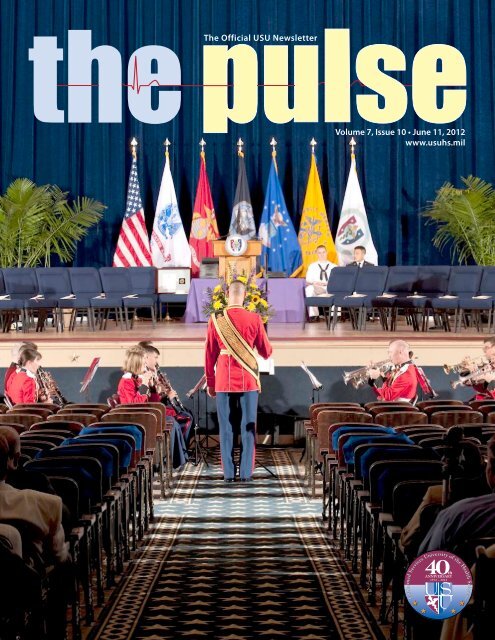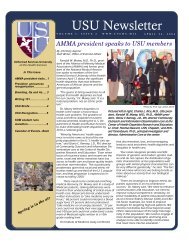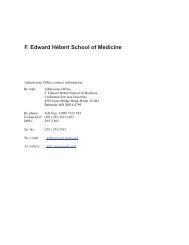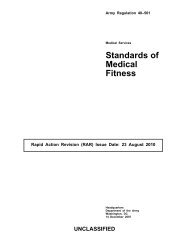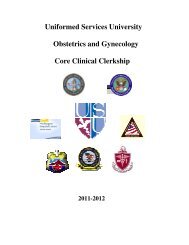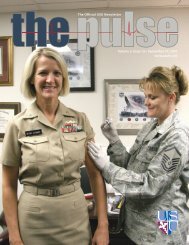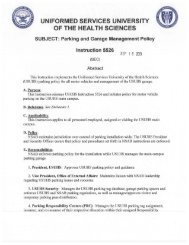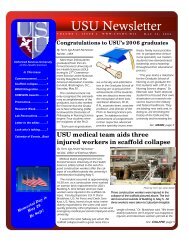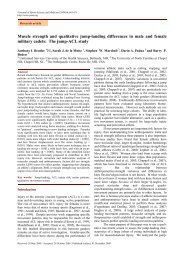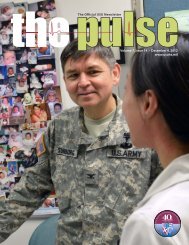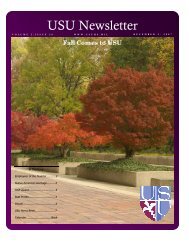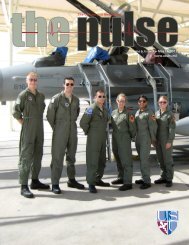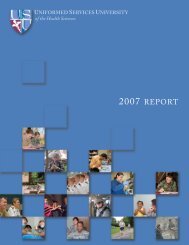Vol. 7, Issue 10 Jun 11, 2012 - Uniformed Services University of the ...
Vol. 7, Issue 10 Jun 11, 2012 - Uniformed Services University of the ...
Vol. 7, Issue 10 Jun 11, 2012 - Uniformed Services University of the ...
- No tags were found...
You also want an ePaper? Increase the reach of your titles
YUMPU automatically turns print PDFs into web optimized ePapers that Google loves.
The Official USU Newsletter<strong>Vol</strong>ume 7, <strong>Issue</strong> <strong>10</strong> • <strong>Jun</strong>e <strong>11</strong>, <strong>2012</strong>www.usuhs.mil
Sharon WillisDeputy Vice President for ExternalAffairs and Managing EditorChristine Creenan-JonesContributing WriterLori FieldsLayout and DesignProductionEditorial content is edited, preparedand provided by <strong>the</strong> USU Office <strong>of</strong>External Affairs unless o<strong>the</strong>rwiseindicated. The Pulse staff mayinclude or exclude articles basedupon news value, impact on <strong>the</strong>university and space availability.SubmissionsThe Pulse will be publishedbi-weekly on Mondays. Thedeadline for submissions is at 4 p.m.Tuesday prior to <strong>the</strong> publicationdate. Submissions can be sent toswillis@usuhs.mil or by calling301-295-3578.Photo by Thomas C. BalfourOn <strong>the</strong> coverThe United States Marine Band—“ThePresident’s Own”—performs as guests arrivefor USU’s 33rd Commencement Ceremony,May 19, at DAR Constitution Hall inWashington, D.C. (See story, page 6.)USU alum shares unique perspectiveabout TBI at CNRM meetingBy Christine Creenan-JonesNavy Captain (Dr.) James Hancock, a USU alumus and director <strong>of</strong> medical services atNaval Medical Center Portsmouth, was <strong>the</strong> keynote speaker at <strong>the</strong> CNRM annual meeting.He discussed traumatic brain injury from both <strong>the</strong> patient and provider’s perspective, twovantages he has experienced as both a physician and wounded warrior.The Center for Neuroscienceand Regenerative Medicine heldits annual meeting at <strong>the</strong> NationalInstitutes <strong>of</strong> Health (NIH), May21-22. During <strong>the</strong> event, several USUexperts shared important researchfindings about Traumatic BrainInjury (TBI) – a common, but vexingwound affecting more than 200,000servicemembers worldwide.The keynote speaker, Navy Captain(Dr.) James Hancock, director <strong>of</strong>medical services at Naval MedicalCenter Portsmouth, also provided aunique glimpse into <strong>the</strong> troublesomedisorder from both a physician andpatient’s point <strong>of</strong> view – a vantagefew o<strong>the</strong>rs in military medicine haveexperienced fully.Before his war injury, Hancock, aseasoned combat surgeon, had treatedmany servicemembers with TBIs,especially while serving on <strong>the</strong> frontlinesin Iraq and Afghanistan, wherehomemade-bomb attacks are common.TBIs – though prevalent at home too– are different, more severe, when <strong>the</strong>yhappen in <strong>the</strong>ater operations, believesHancock, a USU graduate (SoM ‘95)with extensive deployment experience.“Brain injuries are more than whatyou see in a lab,” he told audiencemembers attending CNRM’s annualmeeting. “They need to be placed in<strong>the</strong> context <strong>of</strong> what Soldiers experienceas well.”In Afghanistan, servicemembersface many challenges, from dangerousliving conditions and extreme climatechanges to separation anxiety andemotional stress. This can affect TBI,said Hancock, who was badly injured byan IED himself.Hancock’s TBI began impactingo<strong>the</strong>r parts <strong>of</strong> his life, includingsleep, balance and various facets<strong>of</strong> his personality. Healing was along, sometimes frustrating process,especially since <strong>the</strong> care he receivedback home was fragmented at times.Like researchers at <strong>the</strong> CNRM,Hancock wanted to excel TBI fronts, sohe began looking for ways to improvewarrior care. His work caught <strong>the</strong>attention <strong>of</strong> several senior militaryContinued to page 9Photo by SPC Ernest E. Sivia III2 The Pulse The Official USU Newsletter
New USAFP President Installed via SkypeBy Sharon WIllisCourtesy Photo/USAFPCourtesy Photo/USAFPUSU graduates are used to addressingand overcoming challenges, andas an Army physician who has beenassigned to support some <strong>of</strong> <strong>the</strong> largestcombat units, Col. (Dr.) Michael Place(SoM ’91) has certainly had his share.Place was elected President <strong>of</strong> <strong>the</strong><strong>Uniformed</strong> <strong>Services</strong> Academy <strong>of</strong> FamilyPhysicians (USAFP), and his installationwas to be held at <strong>the</strong> <strong>2012</strong> USAFPnational meeting in front <strong>of</strong> <strong>the</strong> membershipwith some amount <strong>of</strong> pomp andcircumstance. But, <strong>the</strong> incoming presidentwas deployed to Afghanistan, and<strong>the</strong> national meeting was in Las Vegas,some 7,500 miles away, presenting aslight dilemma for <strong>the</strong> (parent organization)American Academy <strong>of</strong> FamilyPhysicians leadership.But on March 22, in front <strong>of</strong> anestimated 600 uniformed family physiciansand <strong>the</strong>ir guests, Place joined hisArmy, Navy, Air Force and Public HealthService colleagues via Skype, <strong>the</strong> Internetphone service with webcam imaging.Attendees burst into wild applause andgave Place a standing ovation as his imageappeared on screen – seated inside a starkmilitary tent in <strong>the</strong> combat <strong>the</strong>ater <strong>of</strong>operations, a world away from <strong>the</strong> glitzand glamour <strong>of</strong> <strong>the</strong> Vegas strip.As <strong>the</strong> fanfare settled, Glen Stream,M.D., M.B.I., president <strong>of</strong> AAFP, turned<strong>the</strong> podium webcam around so thatPlace, who has rarely missed a chaptermeeting in almost two decades, couldsee <strong>the</strong> audience.“When Dr. Stream turned <strong>the</strong>camera to <strong>the</strong> members <strong>of</strong> <strong>the</strong>USAFP during <strong>the</strong> installation, I wasabsolutely overwhelmed,” Place wasquoted in an AAFP News article. “TheUSAFP annual meeting is not only aCME extravaganza and a display <strong>of</strong>some <strong>of</strong> <strong>the</strong> finest clinical research inprimary care, but truly is a reunion <strong>of</strong>friends who span <strong>the</strong> globe in serviceto our nation.“Some <strong>of</strong> my closest friends were<strong>the</strong>re,” he continued. “For that group<strong>of</strong> people to give me a standing ovationwas pr<strong>of</strong>oundly humbling.”“I’ve installed 16 chapter presidentsduring my years on <strong>the</strong> AAFP Board<strong>of</strong> Directors and I’ve heard some prettygood speeches,” said Stream in an AAFPblog post about <strong>the</strong> event. “But nothingcompares to that inspiring day.”Place is <strong>the</strong> commander <strong>of</strong> <strong>the</strong><strong>10</strong>th Combat Support Hospital.While deployed he also serves as <strong>the</strong>commander <strong>of</strong> a medical task force.He has previously served as divisionsurgeon for <strong>the</strong> <strong>10</strong>1st AirborneDivision, and command surgeon for <strong>the</strong>U.S. Army Cadet Command, amongo<strong>the</strong>rs assignments.O<strong>the</strong>rs with USU ties joiningPlace on <strong>the</strong> current USAFP leadershipteam are President-elect AirForce Lt.Col. (Dr.) Pamela Williams,former assigned faculty in <strong>the</strong> USUDepartment <strong>of</strong> Family Medicine,Past-President Navy Capt. (Dr.)Maureen Padden (SoM ’92), andBoard <strong>of</strong> Directors members AirForce Maj. (Dr.) Marc Childress(SoM ’02), Air Force Lt. Col. (Dr.)Christopher Paulson (SoM ’96), AirForce Lt. Col. (Dr.) John Hallgren(SoM ’95), Army Lt.Col. (Dr.)Michael Oshiki (SoM ’98), Air ForceCapt. (Dr.) Brooke Sciuto (SoM ’<strong>10</strong>),Army Capt. (Dr.) Caitlyn Rerucha(SoM ’<strong>11</strong>), and Air Force 2nd Lt.Rebecca Lauters (SoM ’14).Important USUSecurity Notes:• USU badge identification(ID) cards are to be worn atall times while on <strong>University</strong>property. Your ID badgeshould be displayed on yourfront between your shouldersand waist. If you see someonewithout <strong>the</strong>ir ID badge challenge<strong>the</strong>m. Remember—security iseveryone’s responsibility.• USU badge ID cards should notbe worn <strong>of</strong>f site. You should notadvertise where, and by whom,you are employed. OPSEC,OPSEC, OPSEC!• Is your security investigation/clearance up to date? If youare unsure, inquire at <strong>the</strong>Security <strong>of</strong>fice.• When you renew your USUbadge ID card, check your CACexpiration date as well.• If you are a contractor and youneed to renew your USU badgeID, please bring with you a signedmemorandum <strong>of</strong> employment onUSU letterhead.<strong>Jun</strong>e <strong>11</strong>, <strong>2012</strong> 3
Artino wins Award forSecond Straight YearBy Sharon WillisNavy Cmdr. Anthony Artino,Ph.D., associate pr<strong>of</strong>essor and healthcareadministrator in <strong>the</strong> Department<strong>of</strong> Preventive Medicine and Biometrics,was presented <strong>the</strong> Charles R.Loar Literary Award from <strong>the</strong> NavyMedical Service Corps for <strong>the</strong> secondconsecutive year.“I’m extremely honored to receive<strong>the</strong> Loar Award a second time,”Artino said. “Although none <strong>of</strong> usconduct research for <strong>the</strong> purpose <strong>of</strong>receiving an award, it’s always nicewhen o<strong>the</strong>rs acknowledge our work.This award is especially meaningfulto me because it comes from aNavy organization, and it seems<strong>the</strong>y appreciate our goal <strong>of</strong> evaluating<strong>the</strong> factors underlying poorperformance in medical school.Ultimately, we believe a betterunderstanding <strong>of</strong> <strong>the</strong>se factors is akey first step in developing suitableAlum shares perspective aboutTBI at CNRM meetingContinued from page 3leaders, including Navy AdmiralMichael Mullen, former chairman <strong>of</strong><strong>the</strong> Joints Chief <strong>of</strong> Staff, who askedHancock to help form a “Gray Team”<strong>of</strong> medical personnel with combatexperience to establish new, improvedmilitary protocols for how TBI washandled on <strong>the</strong> battlefield.Although, <strong>the</strong> Gray Team has madeconsiderable headway for a troublesomeproblem dubbed <strong>the</strong> signatureinjury <strong>of</strong> today’s war, TBI is still avery complex wound. At <strong>the</strong> meeting,Hancock implored audience membersto find solutions, especially people at<strong>the</strong> CNRM who have <strong>the</strong> knowledgeand expertise to continue making abig difference.“Get out <strong>of</strong> your box, be inventive,”he told <strong>the</strong>m. “You are <strong>the</strong> future. Youremediation plans for strugglingmedical students.”The Loar Award recognizes excellencein pr<strong>of</strong>essional and technicalwriting and is presented to an <strong>of</strong>ficerwhose paper focuses on healthcareadministration, leadership, ormanagement, particularly <strong>of</strong> interestto military medicine or Navymedicine. Winners receive <strong>the</strong> awardduring <strong>the</strong> annual Lewis E. AngeloPr<strong>of</strong>essional Symposium.“This is <strong>the</strong> second year in a rowI have accepted this award on Tony’sbehalf. This award represents Tony’scommitment to outstanding scholarshipand research,” said Cmdr. Glen Diehl,program director for USU’s Master<strong>of</strong> Public Health Administration andPolicy degree program. “We appreciatehis hard work and his ability to put USUfront and center in everyone’s mindwhen it comes to education.”are going to solve some <strong>of</strong> <strong>the</strong> biggestproblems out <strong>the</strong>re.”The creative, analytical thinkingHancock encouraged at <strong>the</strong> meetinghas been driving CNRM researchersfor <strong>the</strong> past four years. They aretackling TBI from all angles, whichincludes developing new diagnosticmeasures and improved treatmentmethods so wounded warriorshave better, more comprehensivecare. Research at <strong>the</strong> CNRM is alsoyielding promising results in cuttingedgescientific fields like biomarkeridentification and neuroregeneration– disciplines that could lead to amajor breakthrough for TBI.Visit www.usuhs.mil/cnrm formore information about <strong>the</strong> center.USU 40th AnniversaryTrivia #2 WinnerCongratulations to RobertaMcIntyre, administrative programspecialist, for being <strong>the</strong> first personto correctly answer last issue’strivia question:Many distinguished people havespoken at USU’s graduationover <strong>the</strong> years, including thiscommencement speaker who said,“Yours is <strong>the</strong> only medical school inAmerica which trains physicians tobe ready for duty on <strong>the</strong> bottom <strong>of</strong><strong>the</strong> ocean or on <strong>the</strong> surface <strong>of</strong> <strong>the</strong>moon and any place in between.”McIntyre answered Ronald Reagan,who was <strong>the</strong> keynote speaker atUSU’s commencement in 1987.4 The Pulse The Official USU Newsletter
<strong>2012</strong>USUCommencement<strong>Jun</strong>e <strong>11</strong>, <strong>2012</strong> 7
USU’s tutoring club: A mind for helpingBy Christine Creenan-JonesArmy Second Lieutenants John Green and Kassandra Khan represented USU at <strong>the</strong>Wheaton High School Career fair, where <strong>the</strong>y are part <strong>of</strong> a university-sponsored clubthat provides free tutorial services to local teenagers.Studying is a part <strong>of</strong> life for moststudents at USU, because <strong>the</strong> curriculumis so challenging. As a result,many <strong>of</strong>ficers develop great learninghabits, which several <strong>of</strong> <strong>the</strong>m arepassing on to younger students atnearby high schools as members <strong>of</strong> auniversity-sponsored tutoring club.The club was formed by USU medicalstudents to give young people <strong>the</strong> edge<strong>the</strong>y need to thrive academically. EverySaturday, club members lead smallgroupstudy sessions covering all subjectareas, so everybody receives hands-on,personalized attention, whe<strong>the</strong>r <strong>the</strong>y’retaking advanced placement math orremedial English.Although <strong>the</strong> club is a large commitment,especially since each tutoringsession lasts about two hours, <strong>the</strong> workis also tremendously satisfying for manyclub members, including Army SecondLieutenant John Green, whose beenvolunteering at Wheaton High School inBe<strong>the</strong>sda for close to a year now.“Education is so important,” he said.“If I can make even a small difference,I’m happy to put in <strong>the</strong> hours.”40thAnniversaryCelebrationSave <strong>the</strong> Date • Sept. 20-22USU bids farewellto senior leaderBy Christine Creenan-JonesFarewells are<strong>of</strong>ten bittersweet,especiallywhen celebratedleaders likeDonna Waechter,Ph.D.Courtesy PhotoDonna Waechter,Ph.D., AssociateDean for MedicalEducation, leaveUSU for newcareer opportunities.The long-time administratorhas accepted a leadership position at<strong>the</strong> Association <strong>of</strong> American MedicalColleges in Washington, D.C.Although she leaves soon, Waechter’smark on <strong>the</strong> campus will remain longafter her <strong>Jun</strong>e departure.Waechter’s impact will resonate mostin <strong>the</strong> School <strong>of</strong> Medicine, where she’slabored tirelessly for <strong>the</strong> past 28 yearsto ensure only <strong>the</strong> highest academicstandards prevail. An accreditation andassessment expert, Waechter has playeda huge role in USU’s growth and developmentover <strong>the</strong> past three decades.Her success is also personifiedby hundreds <strong>of</strong> military physiciansstationed across <strong>the</strong> globe – alumni sheboth counseled and mentored whileworking as Deputy Assistant Dean in<strong>the</strong> Office <strong>of</strong> Student Affairs, her firstjob at USU. Over <strong>the</strong> years, Waechtermaintained a close relationship wi<strong>the</strong>ach class, even earning two covetedOutstanding Civilian Educator Awards,a testament to both her popularity andeffectiveness as a classroom instructor– ano<strong>the</strong>r role she’s taken on at USU.Waechter’s colleagues also hold herin high regard. She will be missed bymany at <strong>the</strong> university, including LarryLaughlin, MD, PhD, dean <strong>of</strong> <strong>the</strong> School<strong>of</strong> Medicine, who has worked closelywith Waechter for many years.“Donna has been an incredible forceon this campus for a very long time,”he said. “She is a big reason why thisuniversity is successful, and while I’msad to see her go, I also realize USUhas been very lucky to have such a fineleader for so many years.”8 The Pulse The Official USU Newsletter


